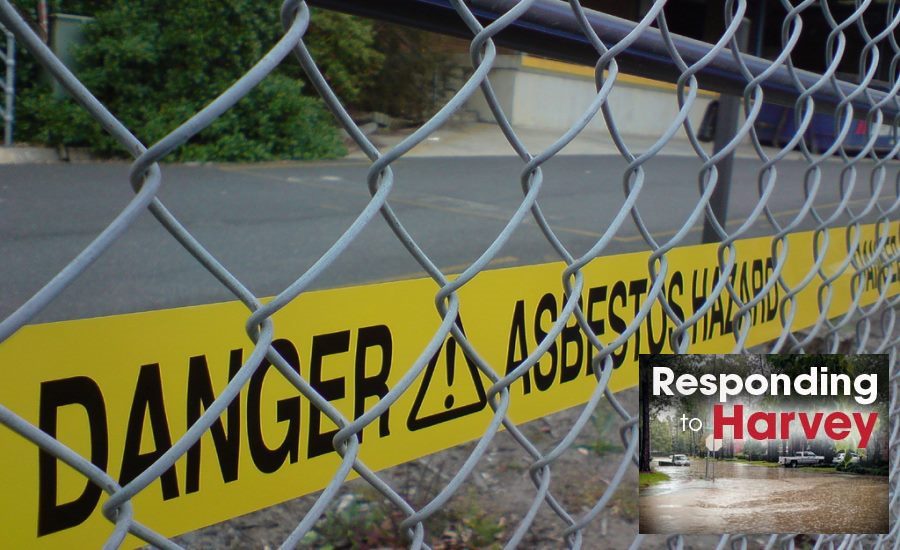Health Concerns for Cleaning Crews after a Natural Disaster
With natural disasters dominating the news over the course of the last two months, the primary concern is for individuals affected to keep their families safe. After, however, many people will come back to damages and health hazards in their homes.
As contractors are hired to go to work helping fix the damages that have been left, they need to be aware of certain dangerous environmental toxins such as asbestos and lead that may be present. These two materials were used in a number of older homes and become a health hazard when damaged or disturbed. Unfortunately, as natural disasters hit homes, they can disturb asbestos and lead. Making these materials unknowingly dangerous for contractors working in the homes on other projects such as mold remediation, water damage in basements, and more.
Read on for a closer look at each material including where workers can expect to find lead and asbestos and how to stay safe while working on the job.
LEAD
Lead is most commonly used in homes built before 1978, according to the Environmental Protection Agency. The EPA estimates that lead paint is still present in millions of homes across the United States.
Other places lead is found in the home are:
- Windows or window sills
- Doors and door frames
- Stairs, railings, and banisters
- Porches
- Plumbing Materials
- Food or Liquid Containers
- Drinking-Water
If the lead paint is in good condition and unchipped, then it is usually not a threat. However, the paint on these surfaces can be hazardous as it goes through normal wear-and-tear. That produces lead dust and chips which can be inhaled or chewed on by children. Lead is known to affect the mental and physical development of children if they are exposed. Although lead poisoning is mostly a concern for children, adults can also develop it as well.
STAYING SAFE
After a natural disaster such as a hurricane occurs, contractors will be called upon to help make repairs to damages in the homes. Contractors should first ask the homeowners of the approximate age of the home, thus determining if the presence of lead is likely. Upon entering homes that have lead paint, contractors need to be aware of possible lead debris in the home and potentially the need to wear a half-face respirator or better.
ASBESTOS
Asbestos is another environmental toxin commonly found in older homes. The Asbestos had regulations put on its use after the material was found as a link to diseases such as asbestosis, mesothelioma, and lung cancer. If the home was built before the mid-1980s, there is a high chance of asbestos.
Asbestos is commonly found in:
- Insulation in walls, pipes, and the attic
- Ceilings
- Certain sidings
- Sheetrock and drywall
- Under floors
- Around boilers and water heaters
As is the case with lead, since asbestos is commonly used as insulation due to its fire-resistant properties, if properly enclosed by pipes, walls, or another surface, it is generally not harmful. However, once disturbed by an unfortunate circumstance like a natural disaster, asbestos released airborne in a home can lead to exposure.
If asbestos fibers are inhaled or ingested, they can easily get lodged into the lining of important organs like the lungs, heart, or abdomen. These fibers cause scar tissue and allow for cancerous cells to grow, causing deadly diseases such as mesothelioma cancer.
STAYING SAFE
Contractors have to be wary of doing repairs on homes with asbestos in them. If a contractor is not licensed to handle dangerous asbestos, they should not try to remove it on their own. Professionals should be contacted to remove asbestos before the job begins. It is important to note that any level of asbestos can cause long-term illnesses. It may only take one case of being exposed to this microscopic fiber for negative health effects to show years down the road. To remove asbestos from a home, professionals operate in full hazmat suits and respirators. As regular masks will not fully prevent asbestos exposure.
If a contractor comes across loose asbestos during a job or accidentally damages asbestos during other repair work. They should not try to touch or remove the asbestos without proper equipment, and instead, immediately contain and leave the area as friable fibers could otherwise be inhaled. If a worker thinks they were exposed to asbestos, they should notify a doctor.
CONCLUSION
As contractors take on jobs to repair homes affected by natural disasters such as Hurricanes Irma and Harvey. They must stay aware of potential dangers that may be lurking behind water-damaged walls and floors. The work contractors take on is important for the victims of natural disasters. However, keeping workers healthy should be a top priority. So stay alert and follow the best preventative measures or allow for a specialized asbestos abatement professional to support your work.

